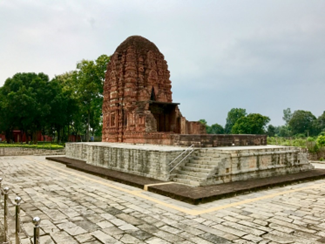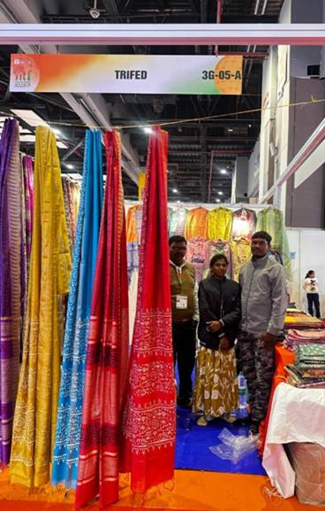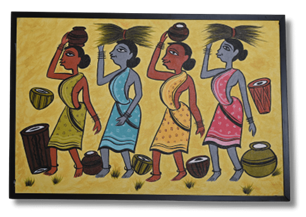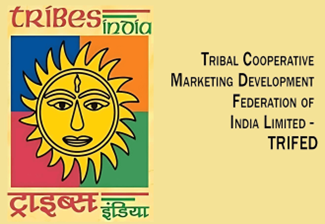History, Art & Culture
Sirpur:
-
- Location: Sirpur, Mahasamund district (Chhattisgarh), on the banks of Mahanadi River.
- Period: Flourished between 5th–12th century; capital of South-Kosala under Panduvanshi rulers.
- Heritage significance:
-
-
- Contains 34 protected monuments:
- 22 Shiva temples, 5 Vishnu temples
- 10 Buddhist viharas, 3 Jain viharas
- Known for religious pluralism, unique brick temple architecture.
- Important structures: Lakshmana Temple, Surang Tila, major Buddhist monasteries.
- Represents a planned ancient urban centre (markets, civic structures, water systems).
- Contains 34 protected monuments:
-
-
- Government’s UNESCO-Preparation Plan
-
-
- Organising monuments into four clusters: Buddhist, Hindu, Civic-Administrative, Riverine landscape.
- ASI to get 30 hectares of surrounding land for integrated management.
- Infrastructure upgrades: heritage pathways, battery-operated carts, better connectivity.
- Visitor facilities: Interpretation Centre, digital exhibits, signage, shelters.
- Focus on eco-friendly tourism, landscaping, local community participation.
- Further archaeological surveys planned.
-

(IE)
India International Trade Fair:
-
- “Tribal Art Showcased at the India International Trade Fair” highlights the participation of tribal communities from across India at IITF 2025.
- More than 705 distinct tribal groups, representing 6% of India’s population are contributing traditional arts, crafts, textiles and handicrafts, thereby preserving India’s living cultural heritage.
- The exhibition features silk-based tribal crafts: tribal artisans engaged in production and weaving silk sarees (e.g. tasar silk) with tribal designs (e.g. from the Gond community) get national exposure.

-
- Rare and endangered tribal art forms such as Paitker painting (also called Pyatkar), native to tribal communities in Jharkhand, get showcased, helping revive and sustain such traditional arts.
- Another example: tribal artists belonging to sub-communities (like the Bharewa — a sub-tribe of Gond) use scrap metal to create statues, jewellery and ornaments, reviving endangered craft traditions.
- The initiative is part of a broader goal: to ensure cultural heritage preservation, support tribal livelihoods, and integrate tribal crafts into India’s socio-economic development as the country aims to become a US$ 5 trillion economy by 2047.
(PIB)
Paitker painting:
-
- One of India’s oldest tribal art forms, practiced mainly by the Chitrakar community of Jharkhand (especially in East Singhbhum and Dumka).
- Considered the “scroll painting tradition” of the region, like Bengal’s Patachitra but with distinct tribal themes.
- Traditionally used for ritual and storytelling, especially during funerary rites and community ceremonies.
- Themes include life–death cycle, heroic tales, village life, tribal deities, and nature.
- Made using natural colours from stones, leaves, and soil; painted on paper or cloth scrolls.
- Currently an endangered tribal art form, showcased in national fairs (like IITF) as part of efforts to revive and support tribal crafts.

(PIB)
Tribal Co-operative Marketing Development Federation of India (TRIFED):
-
- Established: 1987, under the Ministry of Tribal Affairs, Government of India.
- Purpose: Promotes tribal art, handicrafts, and minor forest produce (MFP); ensures fair prices and market linkages for tribal products.
- Functions:
- Marketing and branding of tribal products (handicrafts, organic produce, tribal art).
- Implementation of Van Dhan Yojana to enhance tribal livelihoods.
- Support for tribal entrepreneurs through training, skill development, and financial assistance.
- Schemes under TRIFED:
- Van Dhan Vikas Yojana – value addition and marketing of Minor Forest Produce.
- TRIFOOD – processing and branding of tribal products.
- Aadi Mahotsav – annual festival to showcase tribal crafts, culture, and cuisine.
- Significance:
- Promotes tribal economic empowerment and livelihood sustainability.
- Preserves and promotes tribal culture and crafts.
- Links tribal producers to national and international markets.

(PIB)
Bharewa:
-
- Ethnic Identity: Bharewa is a sub-tribe of the Gond community, one of the largest tribal groups in India.
- Geographical Distribution: Mainly found in Chhattisgarh, Madhya Pradesh, Maharashtra, and Odisha.
- Cultural Practices:
- Follow traditional Gond customs, festivals, and rituals.
- Known for folk art, music, and handicrafts, often linked to religious and seasonal celebrations.
- Economic Activities:
- Traditionally agriculture and forest-based livelihoods.
- Skilled in crafting ornaments and artefacts using scrap metal and locally available materials.

(PIB)
PRACTICE MCQ’S
Q1. Consider the following statements regarding the Sirpur archaeological site in Chhattisgarh:
1. Sirpur contains monuments belonging to Hindu, Buddhist, and Jain traditions, reflecting a multi-religious cultural landscape.
2. The Government plans to organise Sirpur’s monuments into thematic clusters and transfer adjoining land to the ASI for integrated management as part of the UNESCO preparation process.
Which of the statements given above is/are correct?
a) 1 only
b) 2 only
c) Both 1 and 2
d) Neither 1 nor 2
Answer: C
Explanation:
-
- Sirpur has a rich multi-religious heritage with Hindu temples (especially Shiva and Vishnu), Buddhist viharas, and Jain viharas. The site is known for religious pluralism between the 5th–12th centuries, making Sirpur a classic example of a multi-religious cultural landscape.
- As part of preparations for a UNESCO World Heritage nomination, the government plans to:
- Organise the 34 monuments into four thematic clusters (Buddhist, Hindu, Civic-Administrative, and Riverine).
- Transfer about 30 hectares of surrounding land to the Archaeological Survey of India (ASI) for unified protection and site management.
- This integrated approach aims to improve conservation, visitor management, and heritage interpretation.
Q2. Paitker painting, often mentioned in the context of India’s tribal art traditions, is traditionally associated with which of the following states?
a) Odisha
b) Jharkhand
c) Rajasthan
d) Madhya Pradesh
Answer: B
Explanation
-
- Paitker Painting is a tribal scroll painting tradition practiced mainly by the Chitrakar community of Jharkhand.
- It is one of India’s oldest tribal art forms and is closely linked with rituals, storytelling, and funerary ceremonies.
- The paintings depict themes like tribal life, deities, nature, and folklore, and are traditionally made using natural colours on cloth or paper scrolls.
- Though similar in technique to Bengal’s Patachitra, it is distinctly a Jharkhand tribal art.
Q3. Consider the following statements about TRIFED (Tribal Co-operative Marketing Development Federation of India):
1. TRIFED functions under the Ministry of Tribal Affairs and primarily focuses on marketing of tribal products and Minor Forest Produce (MFP).
2. Van Dhan Yojana implemented by TRIFED is aimed at promoting tribal entrepreneurship through value addition and skill development of tribal products.
3. TRIFED also runs TRIFOOD, a scheme for branding and processing tribal food products.
4. TRIFED is a statutory body created under the Constitution (Scheduled Tribes) Act, 1987.
Which of the statements given above are correct?
a) 1, 2 and 3 only
b) 2 and 4 only
c) 1 and 4 only
d) All the above
Answer: A
Explanation:
TRIFED operates under the Ministry of Tribal Affairs to promote tribal products and MFP marketing.
Van Dhan Yojana focuses on tribal entrepreneurship, value addition, and skill development.
TRIFOOD handles branding/processing of tribal food products; Aadi Mahotsav showcases tribal crafts and culture.
TRIFED is not a statutory body under the Constitution, it was established in 1987 as a society under the Societies Registration Act.
Q4. Consider the following statements about Bharewa tribe:
1. The tribe is primarily known for their metal craft tradition, including making ornaments and statues from scrap metal.
2. They are concentrated mainly in Rajasthan and Gujarat.
Which of the statements given above is/are correct?
a) 1 only
b) 2 only
c) Both 1 and 2
d) Neither 1 nor 2
Answer: A
Explanation:
-
- The Bharewa, a sub-tribe of Gond, are known for their skill in making ornaments, statues, and decorative items using scrap metal, preserving traditional craft techniques.
- Bharewa are concentrated in central India (mainly Chhattisgarh, Madhya Pradesh, and adjoining areas), not Rajasthan or Gujarat.
Q5. Consider the following statements about Sirpur, Chhattisgarh:
1. It is located on the banks of the Mahanadi river.
2. The site contains Buddhist viharas, Jain viharas, Shiva temples.
3. The government’s UNESCO preparation plan includes dividing monuments into clusters, developing eco-friendly tourism, and providing modern visitor facilities.
4. Sirpur is mainly known for its stone temple architecture.
Which of the statements given above are correct?
a) 1 and 2 only
b) 1, 2, and 3 only
c) 2 and 4 only
d) 1, 2, 3, and 4
Answer: B
Explanation:
Statements 1, 2, and 3 are correct as per historical and current UNESCO preparation plans.
-
- It is located on the banks of the Mahanadi River, flourished as the capital of South-Kosala under the Panduvanshi rulers between the 5th and 12th centuries.
- The site contains Buddhist viharas, Jain viharas, and more than 20 Shiva temples, reflecting its religious pluralism.
- The government’s UNESCO preparation plan includes dividing monuments into clusters, developing eco-friendly tourism, and providing modern visitor facilities.
Statement 4 is incorrect because Sirpur is especially known for its unique brick temple architecture, not primarily stone structures.
Spread the Word
